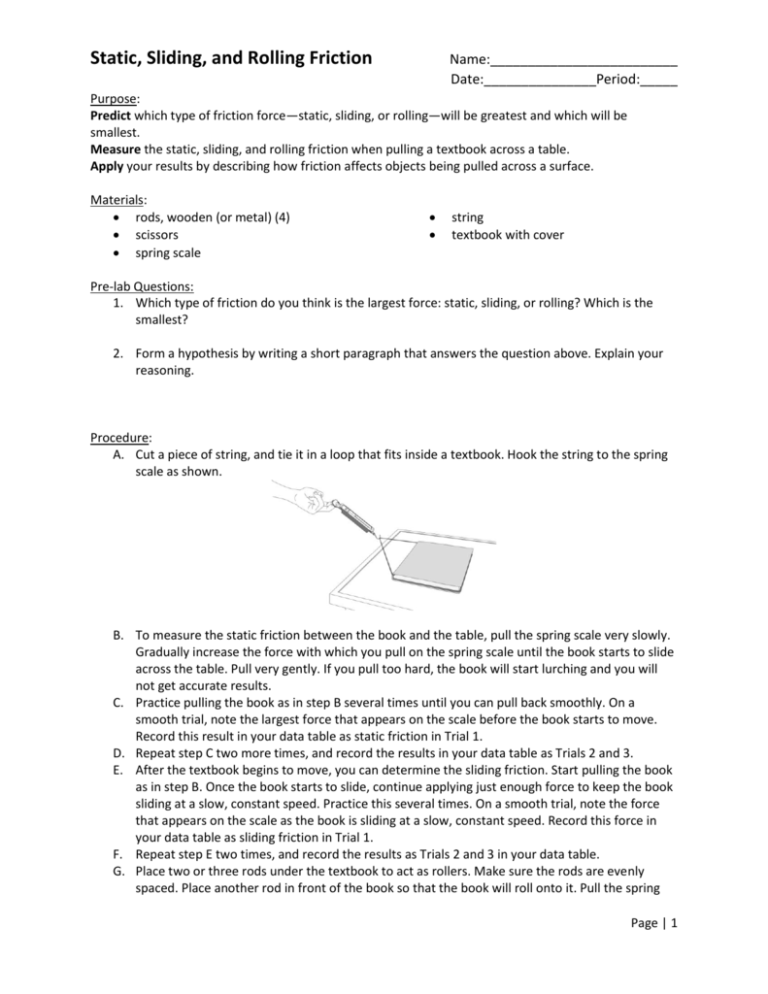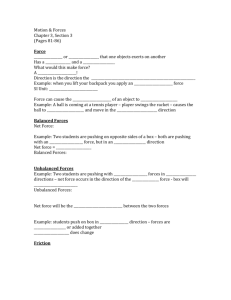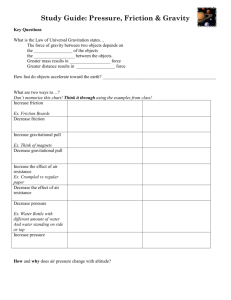Static, Sliding, and Rolling Friction
advertisement

Static, Sliding, and Rolling Friction Name:_________________________ Date:_______________Period:_____ Purpose: Predict which type of friction force—static, sliding, or rolling—will be greatest and which will be smallest. Measure the static, sliding, and rolling friction when pulling a textbook across a table. Apply your results by describing how friction affects objects being pulled across a surface. Materials: rods, wooden (or metal) (4) scissors spring scale string textbook with cover Pre-lab Questions: 1. Which type of friction do you think is the largest force: static, sliding, or rolling? Which is the smallest? 2. Form a hypothesis by writing a short paragraph that answers the question above. Explain your reasoning. Procedure: A. Cut a piece of string, and tie it in a loop that fits inside a textbook. Hook the string to the spring scale as shown. B. To measure the static friction between the book and the table, pull the spring scale very slowly. Gradually increase the force with which you pull on the spring scale until the book starts to slide across the table. Pull very gently. If you pull too hard, the book will start lurching and you will not get accurate results. C. Practice pulling the book as in step B several times until you can pull back smoothly. On a smooth trial, note the largest force that appears on the scale before the book starts to move. Record this result in your data table as static friction in Trial 1. D. Repeat step C two more times, and record the results in your data table as Trials 2 and 3. E. After the textbook begins to move, you can determine the sliding friction. Start pulling the book as in step B. Once the book starts to slide, continue applying just enough force to keep the book sliding at a slow, constant speed. Practice this several times. On a smooth trial, note the force that appears on the scale as the book is sliding at a slow, constant speed. Record this force in your data table as sliding friction in Trial 1. F. Repeat step E two times, and record the results as Trials 2 and 3 in your data table. G. Place two or three rods under the textbook to act as rollers. Make sure the rods are evenly spaced. Place another rod in front of the book so that the book will roll onto it. Pull the spring Page | 1 Name:_________________________ Static, Sliding and Rolling Friction scale slowly so that the book rolls across the rods at a slow, constant speed. Practice this several times, repositioning the rods each time. On a smooth trial, note the force that appears on the scale as the book is moving at a slow, constant speed. Record this force in your data table as rolling friction. H. Repeat step G two times, and record the results in your data table. Data: Static Friction (N) Sliding Friction (N) Rolling Friction (N) Trial 1 Trial 2 Trial 3 Average Analysis: 1. For each type of friction, add the results of the three trials and divide by three to get an average. Record these averages in your data table. 2. Which of the three types of friction was the largest force on average? 3. Which of the three types of friction was the smallest force on average? Conclusions: 4. Did your answers to Analysis questions 2 and 3 agree with the hypothesis you made before collecting data? If not, explain how your results differed from what you predicted. 5. Imagine that you are an engineer at a construction site. You are planning to drag a heavy load of building materials on a palette by using a cable attached to a truck. a. When will the force exerted by the cable be greatest, before the palette starts moving or while it is moving? b. How could you reduce the amount of force needed to move the palette? 6. In each trial, the force that you measured was actually the force that you were exerting on the spring scale, which was in turn exerted on the book. Why could you assume that this was equal to the force of friction in each case? Page | 2







